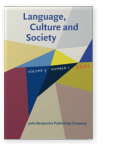Vol. 3:1 (2021) ► pp.107–141
Linguists on the move in the global landscape?
Mobility, metapragmatics and markets in academic capitalism
This paper focuses on the sociolinguistic effects of tightening job markets in applied linguistics, and situates the discussion within the time-space compression of late modernist capitalist enterprises using frameworks in the sociolinguistics of mobility, political economy and raciolinguistics. The paper focuses on single-utterance speech acts of reservation conspicuously invoked to frame the discourse of dissent on the part of committee members in high-stakes interview encounters. Focusing on locally-sourced data collected in a publicly-funded, U.S. university, the paper examines how macro-contexts of skill oversaturation in the job market serve to frame enactments of stance in these high-stakes interactional microcosms while pointing to novel epistemological trending in complexity, conviviality and cosmopolitan encounter.
Article outline
- Introduction
- Complexity, conviviality and cosmopolitan encounter
- Raciolinguistic frameworks and free market capitalism
- Background details: Market triggers
- Academic markets – The consequences
- Data collection dilemmas
- The on-campus interview
- Conviviality, indexicality and meta-level perlocutionary evaluations in the hiring process
- Demeanor indexicals: A study in disqualifiers
- On being ‘Out of place’: Linguistic (in)comprehensibility
- Spotlighting the sociolinguistics of onomastics
- The “space” for difference in academia
- New prejudices or ancient anxieties in the academy?
- Language in society: Theoretical implications
- Acknowledgements
-
References
